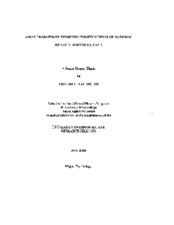| dc.creator | Miller, Erin Michelle | |
| dc.date.accessioned | 2013-02-22T20:41:23Z | |
| dc.date.available | 2013-02-22T20:41:23Z | |
| dc.date.created | 2004 | |
| dc.date.issued | 2013-02-22 | |
| dc.identifier.uri | https://hdl.handle.net/1969.1/ETD-TAMU-2004-Fellows-Thesis-M55 | |
| dc.description | Due to the character of the original source materials and the nature of batch digitization, quality control issues may be present in this document. Please report any quality issues you encounter to digital@library.tamu.edu, referencing the URI of the item. | en |
| dc.description | Includes bibliographical references (leaves 60-62). | en |
| dc.description.abstract | My research looks at how the institution of the home shaped the British colonial project. Colonialism is rooted in the conflict of national identity. Colonial subjects in the presence of a politically threatening "Other" combatted opposition to their national identities in various ways - British citizens attempted to re-create England in India and Indian citizens attempted to defend their nationality against British invasion. Current research in postcolonial studies has focused on the symbolic value of the home within the colonial project. My thesis extends current research by exploring the tangible elements of domestic space and the material underpinnings of how the idea of "home" is tied to "nation." This project is organized around four significant spaces in colonial homes: the courtyard, the drawing room, the verandah, and the zenana, all of which were culturally significant and powerful within the colonial context. Home management guides and domestic manuals written for English settlers moving to India provide a wealth of knowledge about the expectations associated with establishing a home in India. Literary sources address these four spaces by depicting the lived experience and the individual response of colonial characters. Integrating these two bodies of resources, my research looks at how the physical elements of the home helped to determine colonial and national identity. Furthermore, my project looks at how colonial subjects used their homes in methodological ways to portray and reaffirm their national identities. | en |
| dc.format.medium | electronic | en |
| dc.format.mimetype | application/pdf | |
| dc.language.iso | en_US | |
| dc.publisher | Texas A&M University | |
| dc.rights | This thesis was part of a retrospective digitization project authorized by the Texas A&M University Libraries in 2008. Copyright remains vested with the author(s). It is the user's responsibility to secure permission from the copyright holder(s) for re-use of the work beyond the provision of Fair Use. | en |
| dc.subject | psychology. | en |
| dc.subject | Major psychology. | en |
| dc.title | Away from home: Domestic constructions of national identity in imperial India | en |
| thesis.degree.department | psychology | en |
| thesis.degree.discipline | psychology | en |
| thesis.degree.name | Fellows Thesis | en |
| thesis.degree.level | Undergraduate | en |
| dc.type.genre | thesis | en |
| dc.type.material | text | en |
| dc.format.digitalOrigin | reformatted digital | en |


